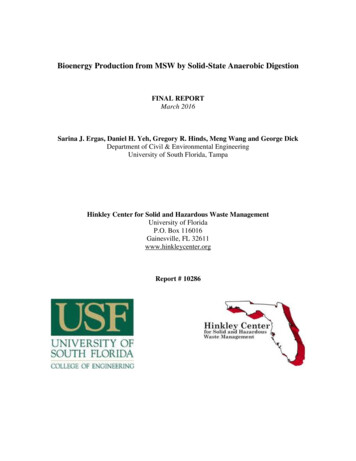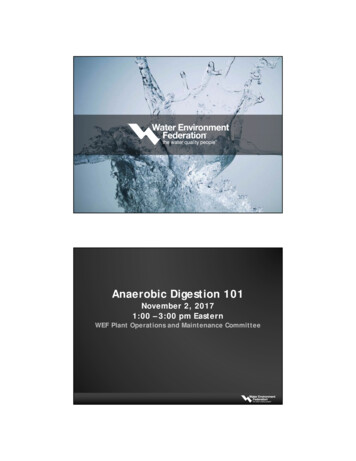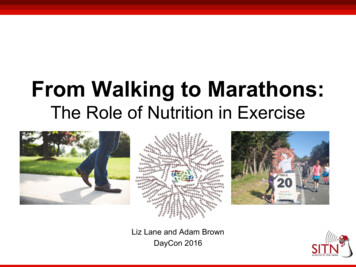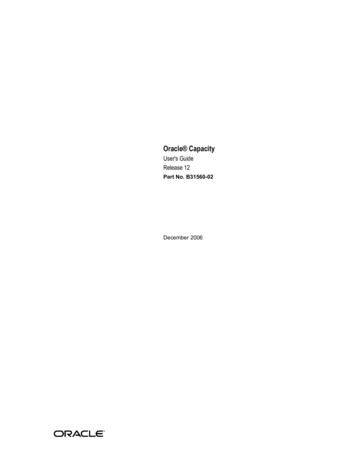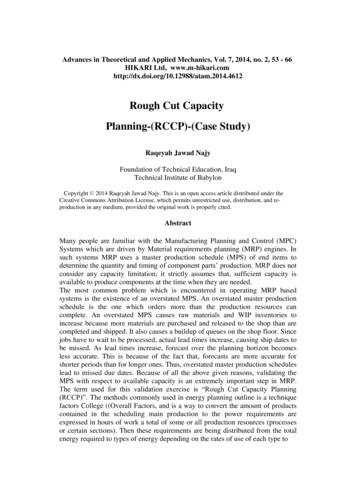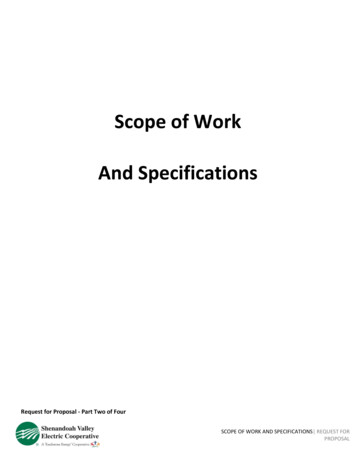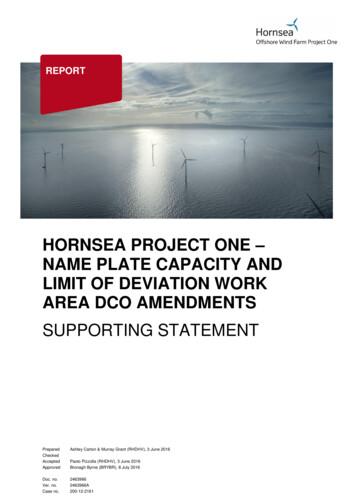
Transcription
(0IUSCLE GLYCOGEN, FIBER TYPE, AEROBIC FITNESS, AND00NANAEROBIC CAPACITY OF WEST COAST U.S. NAVYIOSEA-AIR-LAND PERSONNEL (SEALS)SDTICELECTEDEC 2 4 199211I. JacobsW. K. PrusaczykH. W. Goforth, Jr.(K1Report No. 92-1092 12 22 192Approved for public relse: distribution unlimited.NAVAL HEALTH RESEARCH CENTERP.O. BOX 85122SAN DIEGO, CALIFORNIA 92186-5122NAVAL MEDICAL RESEARCH AND DEVELOPMENT COMMANDBETHESDA, MARYLANDCI
Muscle Glycogen, Fiber Type, Aerobic Fitness, and Anaerobic Capacityof West Coast U.S. Navy Sea-Air-Land Personnel (SEALs)Ira Jacobs'W. Keith Prusaczyk2Harold W. Goforth, Jr. 3t1 J i-.!By .Naval Health Research CenterP.O. Box 85122San Diego,.-Coat!.i-.California 92186-5122. . Dl:P cIlalD1Report No. 92-10, supported by the Naval Medical Research and DevelopmentCommand, Department of the Navy, Bethesda, Maryland under work unit 62233NMM33P30.002-6005. The views expressed in this paper are those of the authors anddo not reflect the official policy or position of the Department of the Navy, theDepartment of Defense, or the U.S. Government.Approved for public release;distribution is unlimited. The investigators acknowledge the command support andparticipation of the Naval Special Warfare Center, SEAL Teams One, Three andFive, SEAL Delivery Vehicle Team One, and Special warfare Group One, NABCoronado, San Diego, California. The assistance of the following individualswith data collection and analysis is gratefully acknowledged: CDR P. Hunt, MC,USNR; P. Griffith, and T. Sopchick from the Naval Health Research Center, SanDiego, California; A. Klugerman, D. Kerrigan-Brown, I. Schmegner, and J. Lauferfrom the Defence and Civil Institute of Environmental Medicine, Toronto, Canada.'Defence and Civil Institute of Environmental Medicine, Toronto, CanadaGEO-CENTERS, Inc., Fort Washington, Maryland23Naval Health Research Center, San Diego, California.'es
ABSTRACTU.S.Thirty-eightand maximalfitnessaerobicNavyLactic acid concentration was measured inparticipatedblood samples collected during theThirty-six subjects had biopsies taken from the vastusaerobic fitness test.lateralis muscle after recording prior dietary intake and physical activity.biopsy results showed that SEALs had a meanof 55% ( 12)fast twitchintake over the two days preceding theDietary carbohydrate( 124) mmol.kgK.significantlyTheconcentration.( SD)TheThe muscle samples had a mean glycogen concentration of 404muscle fiber type.biopsy wasinergometer.tests on a (p 0.01)resultsofcorrelatedthebiopsywith extant muscle glycogenindicatethatSEALshaveanunremarkable fiber type composition (55% 12% fast twitch) and a muscle glycogenconcentrationglycogen(404 128 mmol.kg-1)depletionoverthat may putdeploymentsuccessivethem at risk ofdays.insidiousMuscleglycogenconcentration was significantly (p 0.01) correlated with prior two-day dietarycarbohydrate intake normalized for body weight (n 21; r 0.63).The bloodlactate concentration during submaximal exercise suggests that ilitaryaerobicpersonnel,approximately equal to that of male college physical education students.Theanaerobic capacity tests indicate that SEALs demonstrate only moderate anaerobicfitness.from:Overall,the results of this study suggest that SEALs would benefita) increasing carbohydrate intake to enhance pre-mission muscle glycogenconcentrations(e.g.,throughdietary carbohydratesupplementation);and b)engaging in combined aerobic and anaerobic training programs that use theimplementationintensity, and duration of exercise.2ofmodespecificity,
INTRODUCTIONSeveral reports have documented the body composition, physical iatedmilitary units (for review, see Vogel,inpersonnelconventionalThe mission requirements of elite1985).combat personnel pose demands for exceptional aerobic fitness and muscular power.physicalTypically,fitnessaerobic and strengthtests that includefitnessmeasures are used to evaluate candidates for entry into such units (e.g., BUPERSNavy Sea-Air-Land personnelManual 1410-380 for U.S.Sect.4 forU.S.Army SpecialForces).Beckett,et al.,do exhibit high fitness1989; Jacobs,Although itfitnessitis6rigorousnot surprising that Speciallevels(e.g.,Muza,et al.,1987;1989).accepted in scientific circles that skeletal muscle fiberischaracteristics (e.g.,to certainet al.,AR 614-200 Ch.Coupled with the regular,physical training that such units undergo,Forces personnel[SEALs],fiber type and muscle glycogen concentration) are d direct determination of these characteristics in SEALs.procedureshasAnthropometriccharacteristics, standardized physical fitness test scores, and physical etexistingal.,1989;descriptiveinformation about SEALs to include aerobic and anaerobic fitness using currenttechnologies and techniques.In addition, percutaneous muscle biopsies obtainedfrom the leg musculature were analyzed for the relative proportion of slow twitchand fast twitch muscle fibers and the concentration of muscle glycogen.METHODSSubiects.The subjects were volunteers recruited from the instructors at the NavalSpecial Warfare Center(NAVSPECWARCEN);Five; and SEAL Delivery Vehicle (SDV)One,Naval Amphibious Base Coronado,members of SEAL Teams One,Three,andTeam One at Naval Special Warfare GroupCalifornia.3After being informed of the
details of the study and the associated risks and discomforts,and signed an informed consent form.all subjects readThe protocol for this study was approvedby the Naval Health Research Center's Committee for the Protectionof teeredcm,participate:24instructorsat12 members of STAL Teams One, Three and Five; and 2 SDV operators.The mean ( SD) age, height,( 5)toand weight for all subjects were 33 ( 5) years, 180and 82.6 ( 7.9) kg,respectively.Muscle Biopsies.Thirty-six of the subjects volunteered for the biopsy procedures.administering a local anaesthetic(lidocaine,10 mg-ml',Aftermixed with 1:100,000epinephrine) to the skin and underlying fascia, a biopsy of the vastus lateralismuscle was performed using the percutaneous needle technique (Bergstrbm,The tissue sample (-60 mg) was immediately divided into two pieces.was frozen ininThe second piece was mounted inisopentanehistochemicalDefencestaining.and Civilstored at -80One pieceliquid nitrogen (-190*C) for subsequent determination of edwithan embedding medium (OCT)andliquidnitrogenforsamples were packed indry ice,shipped to theInstitute of C until analyzed.Each muscle tissue sample used for the glycogen assay was frceze-dried.Three pieces of each sample were then dissected free of dried blood,connectivetissue,(1glycogenand fat.assayed(Karlsson,1971).Each piece was hydrolyzed inhydrochloricas glucose residues using an enzymaticMuscleglycogen concentrationconcentration of the three pieces assayed.acidfluorometricwas expressedandmethodas the meanThe coefficient of variation forglycogen determination among pieces from the same sample was 5.2%.4N),
The OCT-embedded tissue samples were cut into 10 pm sections using an AOHistostat microtome at -200C.twitch(ST)The proportion of fast twitchfibers was determined from histochemicalATPase activity (Brooke and Kaiser,1970; Doriguzzi,At the time the biopsy was taken,their physical(FT)and slowstains for myofibrillaret al.,1983).subjects completed a form documentingtraininig and nutritional intake histories for the 36-48 hourspreceding the biopsy.Aerobic Fitness Test.performance was evaluated based on the blood lactateAerobic enduranceresponse to a progressive load-incremented cycle exercise test.Exercise wasperformed on a mechanically braked bicycle ergometer (Monark) at a pedalling rateof 60 rev-min'.Power output began at 60 W and was increased infashion by 60 W at the end of each fourth minute.subjectcould not maintain 60 rev-min-'.a step-wiseThe test continued until theTo arterializethe capillary bloodsampled during exercise, an ointment (Finalgon ) which causes local vasodilationand hyperemia,hyperemia,was applied to one ear lobe.Following a 10-minute wait to insurethe ear lobe was cleaned of remaining ointment and a small incision( 5 mm) was made on the inferior edge of the ear lobe.was maintainedduringexercise byalcohol-soaked gauze pad.eachpowercollectedoutputinastagecoveringthe earPatency of the incisionlobe withanisopropylOnce prior to exercise (resting) and at the end of(i.e.,capillary tubeeveryfourth minute),from the incision,20expelledpL ofbloodwereinto 0.4 mmol-L'1perchloric acid,and stored at -80 0 C until assayed for lactate concentration(Maughan,Respiratory gas exchange (Sensormedicso Horizon 4400 Metaboliccart),1982).heartrateexertion (Noble,(Polaret edwere determined during the final 30 seconds ofeach power output.5
Anaerobic Fitness Test.Following the aerobic fitness test, the subjects were allowed to recoverfor 90 minutes.anaerobicThe ability to transduce energy to the thigh musculature viaenergy metabolism was evaluated by determining the maximaldeficit accumulated during a short (- 2 min) cycle exercise test.exercised at a power output calculated to elicitoxygenThe subjects120% of the peak oxygen uptakedetermined during the aerobic fitness test.Based on the results of the aerobicfitness test,individual linear regressionequations of oxygen uptake ndtheaerobiccomponent) of the anaerobic fitness test was known for each individual.Duringthis test,(i.e.,the subjects pedalled the ergometer at a frequency of 75 rev-min-'.Oxygen uptake (VO,)Metabolic cart).was monitored during the test (Sensormedics Horizon 4400The differencebetween the VO, elicited and the calculatedoxygen demand of exercise was considered to be the maximal oxygen deficit (Medbo,et al.,1988).Following this test, subjects recovered by pedalling at 37 W forfive minutes.RESULTS AND DISCUSSIONMUSCLEBIOPSYRESULTSMuscle Fiber Type Composition.(percent FT)of SEALs inThe mean( SD)this study was 55% ( 12%),fiber type compositionranging from 27% to 87%.The fiber type composition appears to be normally distributed (Figure 1).studies of elite combat units have reported vastus lateraliscompositions of 60% ( 11%) FT in(Jacobs,et al.,1989),30 Canadian Forces (CF)Othermuscle fiber typeinfantry commandosand 48% ( 11%) FT in 21 Swedish coastal commandos.,Theproportion of FT fibers in this sample is slightly greater than that reported forcivilian populations (see Saltin and Gollnick,1983).Insert Figure I about hereJacobs,unpublished data.6
The relevance of muscle fiber type composition to physical performance isbased upon the metabolic and contractile property differences between ST and FTfibers(see Saltin and Gollnick,musclecomposedofalargeInfor detailed ue-resistantcontractile characteristics,and a metabolic profile conducive to aerobic energytransduction.a muscle high inalmostIncontrast,twice as fastmetabolicprofileas one with tageousprolonged,formusculature high inFT T fibers isreaches peak tensionST fibers,viaand the FT ndSTarethefibersotherhand,advantageous for explosive power generation.In terms of performance prediction,prior knowledge of muscle fiber type isoflimited value because fiber type proportions are primarily genetically determined(Komi,et al.,1977); however,fiber type composition may be a good indicator ofa muscle's ability to adapt to a specific type of physical training.MuscleGlycocqen.mmol'kg-',),,range wasglycogen concentrationwas 404and ranged from 170 to 679 mmol-kg',,,i& (Figure 2).likely dueactivity priorMean muscleinto thepart to the lack of controlbiopsy.Figure(t 124)The broadover diet and physical3 shows that theSEALs'mean muscleglycogen concentration is lower than, but similar to, values previously reportedfor well-fed and well-rested infantry commandos in Sweden (570 mmol-kg-1; Jacobs,et al.,1983a)and Canada (412 mmol-kg'; Jacobs,et al.,1989).Insert Figures 2 & 3 about ed,individuals has been reported to range from 348 to 435 mmol.kg'Hultman,1967; Hultman,of approximately1967).(Bergstr6m andAerobically-trained individuals consuming a diet45% to 50% carbohydrateshave been reportedglycogen concentrationsranging from 565 to 587 mmol.kg'.possibleathletesfor endurancesedentaryto achieve7to have en
concentrations of 740 to 910 mmol-kg'after resting several days and consuminga high carbohydrate diet (see Conlee,1987).Resting muscle glycogen concentrations are affected by both short-term ill,etal.,1981).Physical training histories obtained prior to the biopsies in this study revealedthat the subjects engaged ina wide variety of exercise modes,frequencies,Exercise modesrunning,and reported by the SEALsVersiclimber ,of West Coast SEALs (Prusaczyk,present study, the majority of subjects (58%)calisthenics,et al.,andthree to four miles running,1990).In thewere engaged in a daily program oflower body endurance exercise that was classified as "light" inor five to ten miles cycling,volumeper day).(i.e.,only 8%daily heavy-volume training (eight to fifteen miles running).Most of the subjects also engaged inRecords ofincludedThese activities are consistent with the training habits of alarger sample (n 102)were engaged inintensities,dietaryregular upper body resistance training.intake and physicaltraining activitiesprevious 36 hours were collected on a subsample (n 21)of subjects.during theTheir meandaily diet was estimated to contain 84 56 g protein (20% of total calories),55 35 g fat (29% of total calories) and 224 126 g carbohydratecalories).This is(51% of totalconsistent with findings from a study of the dietary habitsof west coast SEALs,2 which estimated a daily intake of 240 g of carbohydrate(42% total calories).the 8-10 g-kg' body wt.This modest intake of carbohydrate is(i.e.,substantially below640-800 g for the average 80 kg SEAL)recommendedfor athletes to facilitate rapid repletion of muscle glycogen stores (Costill,et al.,1981).2 Goforth, H.W.,unpublished data8
Itof some interest that eight SEALsisexhibited resting muscle(22%)glycogen concentrations of less than 320 mmol-kg',.,., which is slightly belowthat reported for untrained, sedentary individuals (348-435 mmol-kg-')and Hultman,1967;Hultman,(Bergstr6m(36 hours),During the pre-biopsy period1967).these eight SEALs had engaged in moderate-to-heavy exercise and consumed a dietestimated to contain less than 126 g of carbohydrate.In contrast, six SEALs (19%)and650 mmol'kg-'dy, i,whichhad resting muscle glycogen levels between 500approximatesthevaluesreportedforindividuals consuming a diet containing 45-50% carbohydrate (Sherman,trained1987).Incomparison to the eight SEALs above, the diet of these subjects contained muchlarger amounts of carbohydrateAmongthesubsetofSEALs(i.e.,with378 158 g or 54% of total ntration was significantly correlated (r 0.62; p 0.01) with prior 24hour dietary carbohydrateintake normalized(i.e.,kg'byi,)for body weight(Figure 4).Insert Figure 4 about hereIfthe muscle glycogen concentrationsseen inthis study represent therange typically found in the SEAL population, then a substantial number of SEALscould be relatively glycogen-depletedindividualswererequired,onshortat any point in time.notice,demanding high rates of energy sfor prolonged periods,they wouldreach glycogen depletion states (muscle glycogen concentrations associated withphysical performance impairments) earlier than SEALs with higher initialconcentrations.glycogenPhysical performance impairments associated with this type ofglycogen depletion have been demonstrated in both laboratory and field settings(Bergstr6m,et al.,1967; Hermansen et al.,1967; Karlsson and Saltin,1971).Glycogen depletion could negatively affect the success of missions requiringtime-dependent coordination of unit movements.Achieving a greater degree ofnutritional homogeneity and physical/mission training activities to maintain high9
levels of resting muscle glycogen concentrations and of physical fitness, may bebeneficial to SEAL performance and aid inmission accomplishment(see Jacobs,1987).SEAL missions also can require an individual to engage inexertion on several consecutive days.Ithigh-intensityhas been well documented that, givensuch a scenario, muscle glycogen levels can become progressively lower with eachsucceedingday(Costill,et ed with glycogen depletion could occur progressively earlier into eachmission segment on successive days of the operation.Itisalso likely thatself-paced work intensity would be reduced due to the decreased availability ofglycogeninthe exercised muscles(Saltin,1972; Askew,et al.,1987).Thisproblem could be further exacerbated by the possibility that, during a prolongedmission, carbohydrate intake, and nutrient intake in general,Glycogen depletion and itscould be limited.associated physical performance impairments mayoccur even earlier than expected during missions involving prolonged cold stress,a situation occurring commonly during SEAL training and operations.some studies (Martineau and Jacobs,all (Young, et al., 1989),to shivering isratesare1988; Martineau and Jacobs,Recently,1989),but nothave found that intramuscular glycogen utilization duegreater during exercise with cold stress than when metabolicelevatedsimilarly duringphysicalexercisewithoutcoldstress.Glycogen depletion in large skeletal muscle groups also appears to be detrimentalto regulation of core body temperature during cold stress (Martineau and Jacobs,1989).Once an individual iscold enough to shiver,even light work in a coldenvironment results in greater glycogen utilization than work performed withoutcold stress (Jacobs, et al.,1985).10
AEROBIC AND ANAEROBIC FITNESS TEST RESULTSAerobic Fitness Indicators.For descriptive purposes,group mean valuesof aerobic fitness indicators (metabolic and perceptual) monitored during theaerobic fitness tests are presented inthrough 8.anTable 1, and graphicallyinFigures 5These values represent a relatively steady-state condition,individual'sdata wereincludedintheanalysisonly ifbecausehe was able tocomplete a full four minutes of exercise at a specific power output.Insert Table 1 about hereInsert Figures 5 through 8 about hereThe kinetics of blood lactate accumulation during exercise are an cobs,1986forareview).Physiological strain during exercise can be accurately equated among subjects fitnesscanat a specificabsolutebebyevaluatedexercise intensity.calculatingtheexerciseintensity required to produce a specific blood lactate concentration (i.e., thehigher the power output required, the more aerobically fitthe subject).Severalprevious studies have used a lactate concentration of 4 mmol.L"' as the referencepoint to evaluate aerobic fitness (e.g.,Jacobs, et al.,1983b; 1985).In the present study, the mean lactate concentration at each power outputwas used to calculatea regression equation best describing the relationshipbetween lactate concentration and power output.best-fit usingan exponentialassociated with a 4 mmol.L'Figure10, this calculatedequation.Figure 9 shows the curve ofFrom this curve,the power outputblood lactate concentration waslactateconcentrationiscalculated.comparedInwith publishedvalues for other population samples tested using similar procedures.The resultssuggest that the SEALs participating in this study had an aerobic fitness levelcomparable to that of male physical education students.lactate1986),concentrationitisrelatedto enduranceInlight of how wellexercise performance(Jacobs,was concluded that the aerobic fitness of the SEALs in this study was11
only average,andwellbelow that whichpersonnel who have engaged inwouldbeexpectedof elitecombatappropriate aerobic fitness training.Insert Figures 9 & 10 about hereAnaerobic Capacity Tests.mL'kgThe mean maximal oxygen deficit was 41 ( 12), ranging from 22 to 68 mL-kgbY .Figure 11 shows the mean maximaloxygen deficit for SEALs in this study compared to mean values recently reportedfor other samples.capacityisThe use of maximal oxygen deficitrelatively new,running as the exercise mode.andmostinvestigatorsto evaluate anaerobichaveemployedtreadmillTreadmill exercise typically results ina 30%higher peak oxygen deficit than does cycling,primarily because of the largermuscle mass recruited (Medbe and Tabata, 1989).Thus, to facilitate comparisons,Figure 11 includes both actual SEAL cycle exercise values and a "corrected" value(30% higher).The corrected mean maximal oxygen deficit for SEALs issimilar tothat reported for healthy, but relatively untrained, male college students.Witha few exceptions in which individuals displayed values typical of sprint-trainedathletes,these SEALs'performance reflected only a moderate level of anaerobicfitness.Insert Figure 11 about hereCONCLUSIONS AND RECOMMENDATIONSThisreportconcentration inCoast SEALs.Itdocumentsthemuscle fiberthe vastus cle of a sample of Westalso presents selected physiologicalresponses of SEALs tolaboratory tests of aerobic and anaerobic physical fitness components.The results of the study suggest that the ability of these SEALs to performprolonged endurance exercise, as well as the generation of maximal muscular powerfor short periods,is not consistent with that expected of an elite combat unit.12
The capacity for individual adaptation to physical training is,one of geneticpredisposition,and cannotbecontrolled.inlarge part,However,factorscritical in the physiological adaptation to training can be controlled.these are the mode,frequency,Amongintensity, and duration of physical training.Itappears that insufficient attention has been paid among SEALs to one or more ofthese controllable factors.Further,anaerobic fitness among these SEALs,mission/training nutrition.foundinthissamplegiven the existing state of aerobic andinadequate attention has been paid to pre-The relatively low muscle glycogen tion-relatedperformance decrements early into strenuous and/or prolonged military operations.Enhancement of muscle glycogen stores could be achieved by increasing the SEALs'dietary carbohydrate intake,perhaps by advocating the consumption of glucosepolymer beverages.Inessentialorder for SEALs to complete mission-critical tasks optimally,thatrequirementstheybeoptimallyof those tasks.trainedfortheaerobicanditisanaerobicTo maximize the benefits gained from physicaltraining programs designed for the development and maintenance of peak fitness,itisalso critical that nutrition programs be implemented that emphasize therelationship to physical performance.Achievement of these goals requires thecontinuing education of SEAL commands,SEAL instructors,and the individualSEAL operatorinthe scientifictraining and performance nutrition.13SEAL platoon leaders,fundamentalsof physical
tokes,W.S.,Sato,Cucinell, S.A. (May, 1987).Mauna Kea III:Metabolic effectscarbohydrate supplementation during exercise at 4100 m altitude.Research Institute of Environmental Medicine Report No. T12-87.A.,andof dietaryU.S. ArmyBeckett, M., Goforth, H.W., and Hodgdon, J. (1989).Physical fitness of U.S.Navy special forces team members and trainees.Report no. 89-29, Naval HealthResearch Center, San Diego, CA.Bergstr6m, J.Suppl. 68.Muscle electrolytes in man.(1962).Scand. J.Clin. Lab. Invest.,Bergstr6m, J., Hermansen, L., Hultman, E., and Saltin, B. (1967).Diet, muscleglycogen and physical performance.Acta Physiol. Scand., 71, 140-150.Brooke, M. and Kaiser, K. (1970).Three myosin ATPase systems.The nature oftheir Ph lability and sulfhydryl dependence.J. Histochem. Cytochem., 18, 670672.Conlee, R.K. Muscle glycogen and exercise endurance: a twenty-year perspective.In: Pandolf, K.B. (ed.), (1987). Exercise and Sport Sciences Reviews. MacmillanPublishing:New York, pp. 1-28.Costill, D.L., Bowers, R., Branan, G., and Sparks, K. (1971).Muscle glycogenutilization during prolonged exercise on successive days. J. Appl. Physiol., 31,834-838.Costill, D.,Sherman, W.,Fink, W., Maresh, C., Witten, M., and Miller, J.(1981).The role of dietary carbohydrates in muscle glycogen resynthesis afterstrenuous running.Amer. J. Clin. Nutr., 34, 1831-1836.Doriguzzi, C., Mongini, T., Palmucci, L., and Schiffer, D. (1983).A new methodfor myofibrillar Ca 2* ATPase reaction based on the use of metachromatic dyes:its advantages in muscle fibre typing. Histochem., 79, 289-294.Hermansen, L., Hultman, E., and Saltin, B. (1967).prolonged severe exercise.Acta Physiol. Scand., 71,Muscle glycogen during129-139.Hultman, E.(1967).Studies on muscle metabolism of glycogen and activephosphate in man with special reference to exercise and diet.Scand. J. Clin.Lab. Invest., 19, Suppl. 94.Jacobs, I.(1986).Blood lactate:performance.Sports Med., 3, 10-25.implicationsfortrainingandsportsJacobs, I. (1987).Nutrition and physical performance in military environments.Defence and Civil Institute of Environmental Medicine Report No. 87-RR-53, NorthYork, Ontario, Canada.Jacobs, I., Anderberg, A., Sch le, R., and Lithell, H. (1983a).Muscle glycogenin soldiers on different diets during military field manoeuvers.Aviat. SpaceEnviron. Med., 54, 898-900.Jacobs, I., Romet, T., and Kerrigan-Brown, D. (1985).Muscle glycogen depletionduring exercise at 90C and 21 0 C. Eur. J. Appl. Physiol. Occup. Physiol., 54, 3539.Jacobs, I.,Sch le, R., and Sj6din, B. (1985).Blood lactate vs. exhaustiveEur. J. Appl. Physiol., 54, 151-155.exercise to evaluate aerobic fitness.14
tatebloodEur. J.determination as an indicator of cycle ergometer endurance capacity.Appl. Physiol., 50, 355-364.Jacobs, I. Van Loon, D., Pasul, L., Pope, J., Bell, D., Kavanagh, M., Beach, A.,Physical performance andM.,and Kerrigan-Brown, D. (1989).Scherzinger,Defence andcarbohydrate consumption in CF commandos during a 5-day field trial.Civil Institute of Environmental Medicine Report No. 89-RR-48, North York,Ontario, Canada.Diet,(1971).Karlsson, J., and Saltin, B.J. Appl. Physiol., 32, 203-206.performance.muscle glycogenandenduranceLactate and phosphagen concentrations in working muscle ofKarlsson, J. (1971).man.Acta Physiol. Scand., Suppl. 358.Komi, P., Viitasalo, J., Havu, M., Thorstensson, A., Sj6den, B., and Karlsson,J. (1977).Skeletal muscle fibres and muscle enzyme activities in monozygous andActa Physiol. Scand., 100, 385-392.dizygous twins of both sexes.I.(1988).Muscle glycogen utilizationMartineau, L. and Jacobs,J. Appl. Physiol., 65, 2046-2050.shivering thermogenesis in humans.I.L.and Jacobs,Martineau,temperature regulation in humans.during(1989).Muscle glycogen availabilityJ. Appl. Physiol., 66, 72-78.andA simple, rapid method for the determination of glucose,Maughan, R. (1982).lactate, pyruvate, alanine, 3-hydroxybutyrate, and aceto-acetate on a single 20Clin. Chim. Acta., 122, 231-240.MI blood sample.(1988). Determinants and effects ofMcDonald, D., Norton, J., and Hodgdon, J.Report No. 88-34, Naval Healthtraining success in U.S. Navy special forces.Research Center, San Diego, CA.Acid-base and electrolyte balance afterMedbe, J.I. and Sejersted, O.M. (1985).Actaexhausting exercise in endurance-trained and sprint-trained subjects.Physiol. Scand. 125, 97-109.Medbo, J., Mohn, A., Tabata, I., Bahr, R., Vaage, 0., and Sejersted, 0. (1988).J. Appl.Anaerobic capacity determined by maximal accumulated 02 deficit.Physiol., 64, 50-60.(1989). Relative importance of aerobic and anaerobicMedbo, J. and Tabata, I.energy release during short-lasting exhausting exercise. J. Appl. Physiol., 67,1881-1886.Muza, S., Sawka, M., Young, A., Dennis, R., Gonzalez, R., Martin, J., Pandolf,K., and Valeri, C. (1987). Elite special forces: physiological description andergogenic influence of blood reinfusion. Aviat. Space Environ. Med., 58, 10011004.NATO Defence Research Group. (August, 1986). Final Report: Physical Fitness inPanel on the Defence Applications of Human and Bio-MedicalArmed Forces.Sciences Document AC/243-D1092.A categoryCeci, R., and Kaiser, P. (1983).Noble, B., Borg, G., Jacobs, I.,ratio perceived exertion scales: relationship to blood and muscle lactates andMed. Sci. Sports Exerc., 15, 523-528.heart rate.(1990). Characteristics ofPrusaczyk, W.K., Goforth, H.W. Jr., and Nelson, M.L.physical training activities of West Coast U.S. Navy Special Forces Team Members.Report No. 90-35, Naval Health Research Center, San Diego CA.15
Saltin, B.137-146.(1972).Metabolic fundamentalsin exercise.Med.Sci.Sports, 5,Saltin, B. and Gollnick, P. (1983).Skeletal muscle adaptability:significancefor metabolism and performance.In: Handbook of Physiology. Skeletal Muscle.Bethesda, MD: Am. Physiol. Soc. sect 10, chapt. 19, pp. 555-631.Scott, C., Roby, F., Lohman, T., and Bunt, J.(1991).oxygen deficit as an indicator of anaerobic capacity.23, 618-624.Sherman, W. (1987).Carbohydrate, muscle glycogenPhysician and Sports Med., 15, 157-164.The maximally accumul
Manual 1410-380 for U.S. Navy Sea-Air-Land personnel [SEALs], AR 614-200 Ch. 6 Sect. 4 for U.S. Army Special Forces). Coupled with the regular, rigorous physical training that such units undergo, it is not surprising that Special Forces personnel
